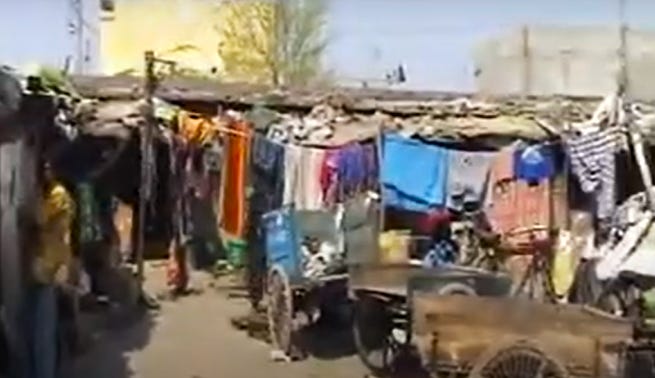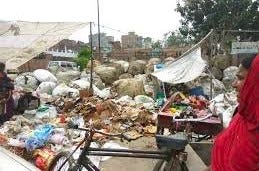Vultures circled overhead as I alighted from the jeep at the entrance of an alley. It led into a slum in east Delhi. I was intrigued by the number of birds until I noticed a grey hill a short distance away. It was a trash landfill. It was over 200 feet tall, attracting vultures who became a part of the local landscape. Dump trucks carved a path winding upwards, while scavengers dotted the terrain. Puffs of smoke swirled through the air, dispersing the toxic fumes of burning plastic, rubber, and Styrofoam. Segregation of waste was uncommon.
It was my first exposure to a city slum on a warm summer day in 2006, a stark contrast to the picturesque campus of Herbertpur Christian Hospital where I worked for 16 years, followed by 6 years in the majestic mountains, the location of the Landour Community Hospital. I was visiting the Sahyog Project, an urban empowerment project of the Emmanuel Hospital Association. As a regional director, I wanted insight into the challenges of slum dwellers in an urban setting, different from the village life I was familiar with. It was equally daunting.
Started in 2005, The Sahyog Project office was in the middle of a narrow street where walking two abreast was difficult considering the drains, potholes, vegetable carts, and food vendors. A variety of noises rent the air - neighbours talking across buildings, children enjoying a game of alley cricket, cart sellers shouting out their wares, and the barking of street dogs. The Sahyog team seemed oblivious as they participated in morning devotion, the pleasant sound of singing rousing the curiosity of passersby who crowded the small door. All were welcome.
Sahyog, Hindi word for ‘support’ or ‘working together,’ prioritised the problems of the slum and framed an action plan to work alongside like-minded community-based organisations. The common goal was to improve the quality of life for slum dwellers by providing social services within reach. The project relied on volunteers as the main task force. Although just over a year old, a model of care emerged which they hoped to extend to 50 slums. I attended the team meeting, awed by reports of the wide range of activities and heartwarming relationships with the most neglected.
One challenge was to fill out forms for basic entitlements such as government identification card, birth certificates, subsidised food supplies, pension, bus passes, or opening a shop. Normally people relied on ‘brokers’ who filled them for a fee with no instructions about what to do with them. The slum dweller had to find and submit the form at a relevant government office in another location, an almost impossible task for those without knowledge and means.
I studied the 4-page document for ‘widows’ to receive a pension. However small the amount, it was a lifeline that saved them from begging on the streets of Delhi. The form defined widows as ‘anyone above the age of 18 years who was divorced, separated, abandoned, deserted, or destitute.’ I was happy for the inclusions but unsettled by what was needed to fall into one of those categories. A woman needed a government issued ID card linked to a bank in Delhi, proof of belonging to one of the widow groups, age proof, and evidence of having lived in the slum for 5 years. A photograph completed the form. The district office had a timeline of one month for data scrutiny and verification. It was rarely met.
If the process seemed impossible for an educated woman like myself, it looked hopeless to an illiterate woman. Until the Sahyog team stepped in.
They filled out forms for free and accompanied women to the district office for submission. There was no guarantee of a response and the form could languish in the office. Until 2005, when the ‘Right to Information Act’ was enacted and implemented in Delhi. It allowed citizens to request updates about the status of their forms. Having learnt the process, the Sahyog team held awareness meetings, later helping with online filing of a request for an update. Surprisingly, the system worked and online postings provided information on the status of the application. Eventually most applications were accepted and requests were fulfilled.
During a women’s meeting in the Sahyog office, I scanned the faces of the women seated on brown plastic chairs. I could feel their optimism as a team member scanned the computer for information about a filing. Another matched the handwritten form to the one on the screen. When a name was called, a woman jumped to her feet, her face alight in eager anticipation. Her joy at the granting of her pension gave hope to the others. It was a happy day when a bank passbook was handed over to a woman with entries of the money. She was elated when, after attending adult literacy classes, she could sign her name rather than use a thumb impression. This was the first time a ‘widow’ felt empowered.
Several women offered to become volunteers and promoters of the Sahyog project. They were trusted in the community and had a wider reach than the Sahyog team who were released to carry out other responsibilities. During subsequent visits I noticed the women’s meetings take on a festive air with animated contributions by those who were once meek spectators. A steady income and literacy were good but being recognised as a Sahyog volunteer provided satisfaction to the soul.
With a trash hill nearby, it was inevitable that a ragpickers colony grew within the slum. The Sahyog team spoke warmly about the valuable work they did in segregating, cleaning, and selling reusable items. I had to see for myself. Picking my way past huts, clotheslines, and children to a sorting area, I watched the precision with which they sorted. The result was neat bundles of cardboard, disposables, and cloth, tied together with rope. Later, buyers came in autorickshaws bringing hope of income for the day.


The children touched my heart. They played with whatever caught their fancy. One little girl, a soiled red and gold ribbon in her hair, caught my eye. She straddled a drain, placing bits of Styrofoam into the black water, fingers skimming the surface. Her laughter rang out as each piece floated away. My stomach dropped. Would she wash her hands before her next meal? Was she oblivious to the flies crawling on her face? How long before she became ill? As a girl child, would her parents seek medical help?
I learnt that most residents of the colony were migrants from Assam. Without language skills, it was hard to find other work. The Sahyog team focused on key issues like maternal and child health, support for the disabled, and adult literacy. Midwives from Herbertpur Christian Hospital instructed women about prenatal care, basics of labour and delivery, newborn care, and immunisation. Sahyog staff identified and directed pregnant women to government owned primary health centres where free care was available. Over time, several of the women became volunteers. They shared their learning with enthusiasm and zeal.
The Sahyog team helped access government schemes for the disabled who were entitled to receive financial support and mobility aids. Lives were changed when someone acquired a walker or a wheelchair. They emerged from their dark homes into the sunlight to converse with passersby. The young paraplegics in wheelchairs learnt to negotiate the narrow streets and attend volunteer training sessions at the Sahyog office. They never imagined a time when they would become useful members of their community.
My visit to the slum left me jarred but encouraged. The Sahyog team viewed the slum as a solvable problem, one person at a time. They demonstrated the love of Christ by journeying with hurting people, providing help where it mattered, investing time and ability to embody Jesus who came to earth for those on the fringes of society.
Their work reminded me of the Irish missionary, Amy Carmichael, who worked for 55 years in south India, rescuing young girls sold to temples for prostitution. The children blossomed under her care, becoming professionals who turned into providers. I had the privilege of working with several of these fine women in EHA hospitals, people of faith, commitment, and integrity. I shuddered at their fate if they had remained in the temples. Amy Carmichael said, “There are always chances for strengthening one another’s hands in God. Let us not lose our chances.”
Jesus taught about unseen acts of love: In Mathew 25:35, He said, “For I was hungry and you gave me food, I was thirsty and you gave me something to drink, I was a stranger and you invited me in.” (NET Bible).







Such a heartwarming story, Ann, showing how the help from EHA just to fill in forms can make a life changingdifference for the desperately poor. Your selfless dedication all those years will never be forgotten by many. Love that part about neat piles of garbage with potential for sale.
This story gives much needed credit to those working in the urban slum area. Never giving up even in the face of severe obstacles, the staff of Sahyog always kept the focus on those needing their assistance, knowing that these poor people did not have any other avenue of help. Thank you Ann for delving into the slum area to detail this wonderful work by Sahyog for the marginalized people. The descriptions bring the toxic fumes and the pollution to a reality.